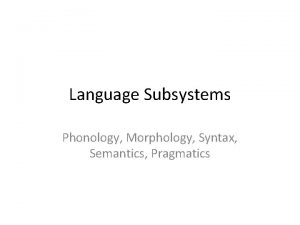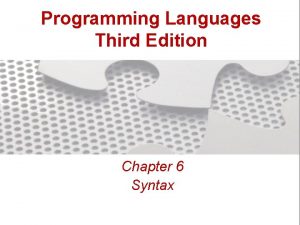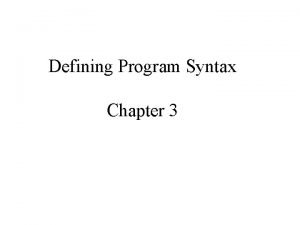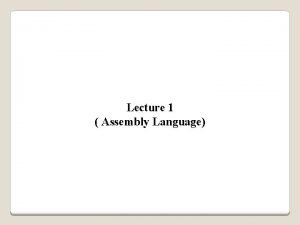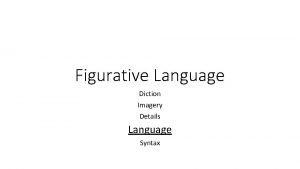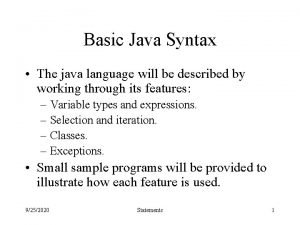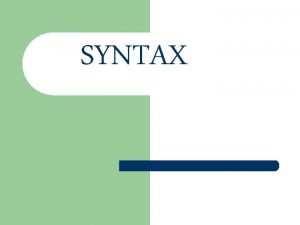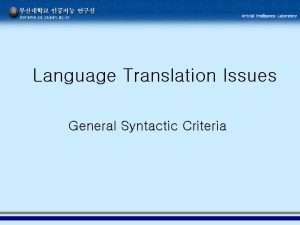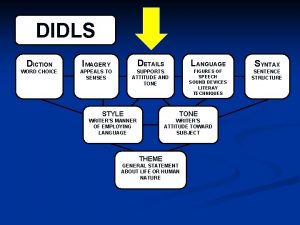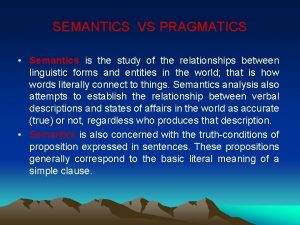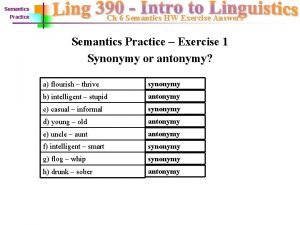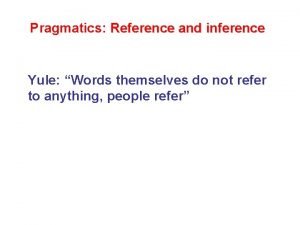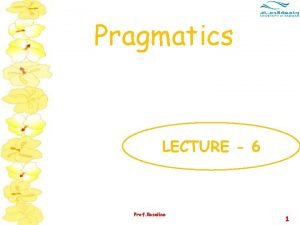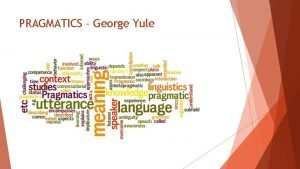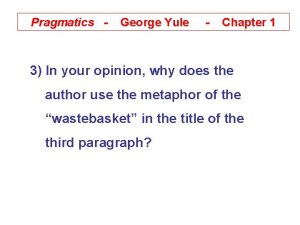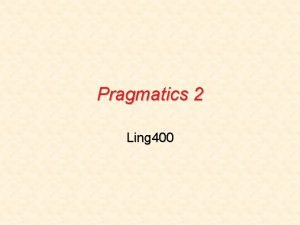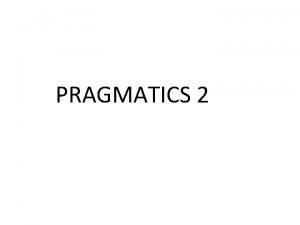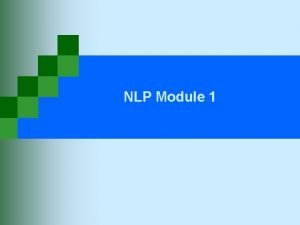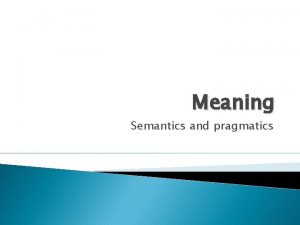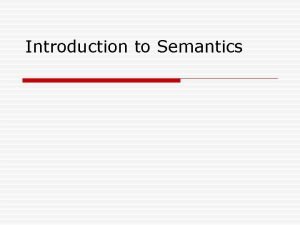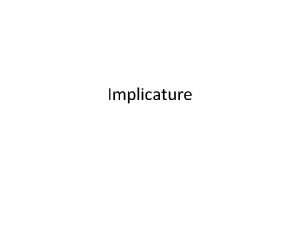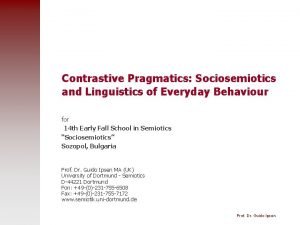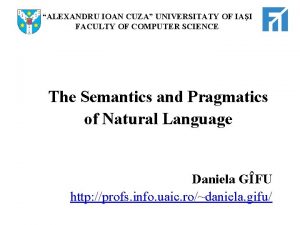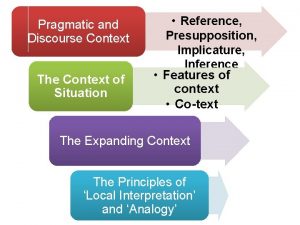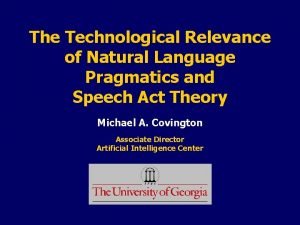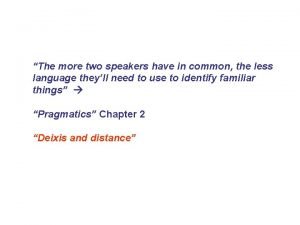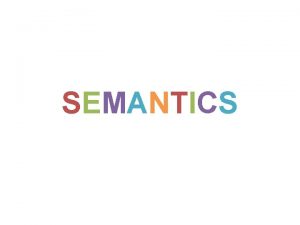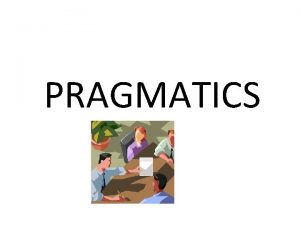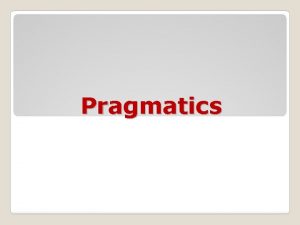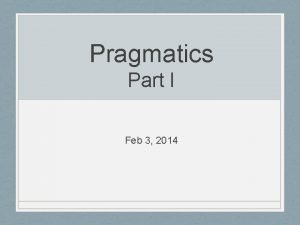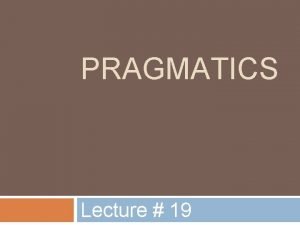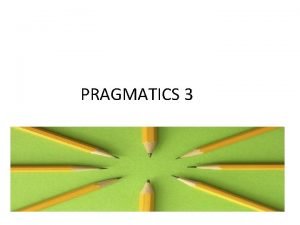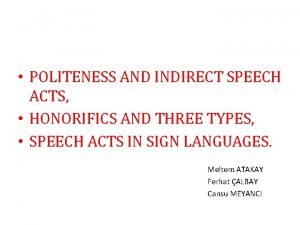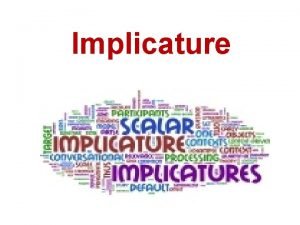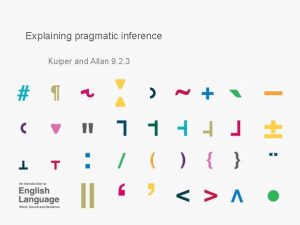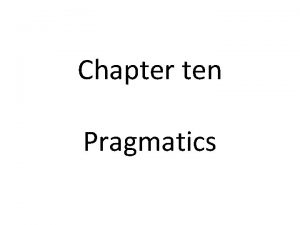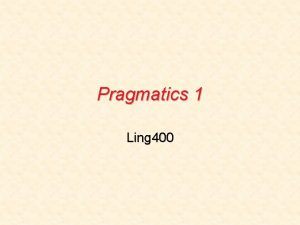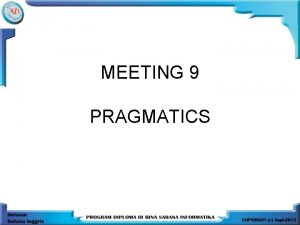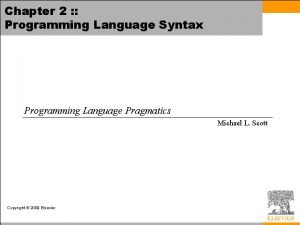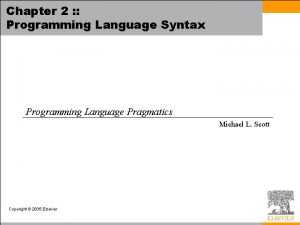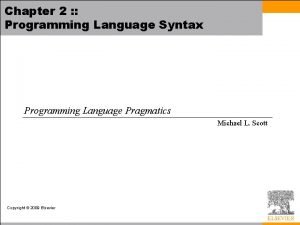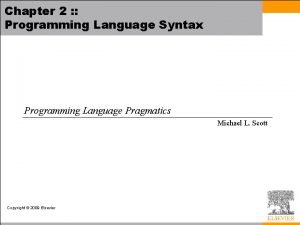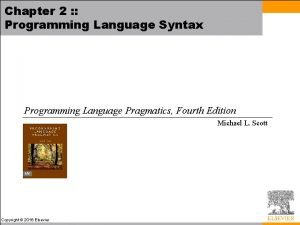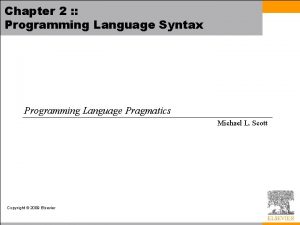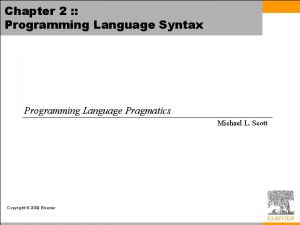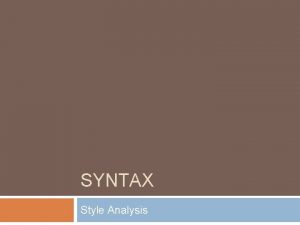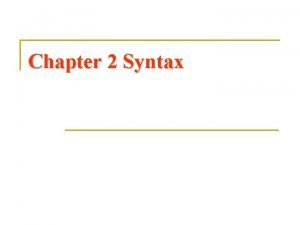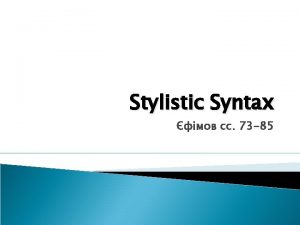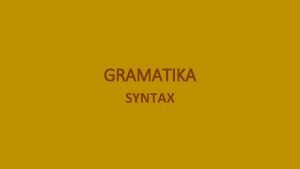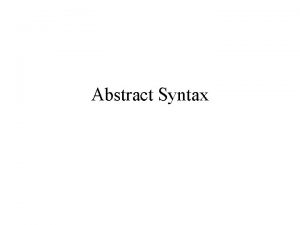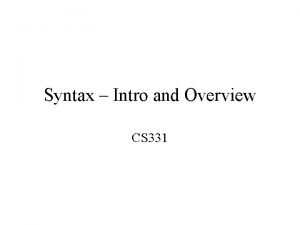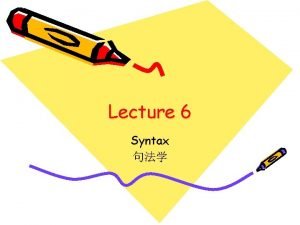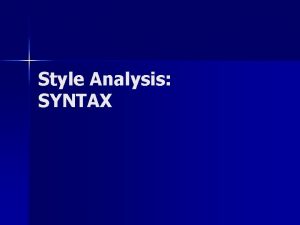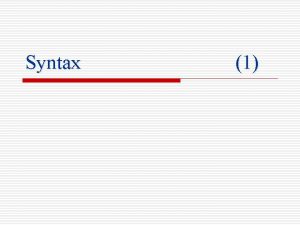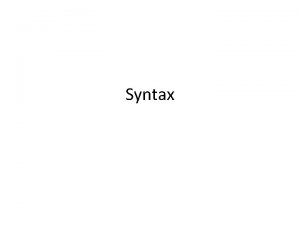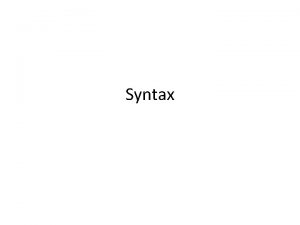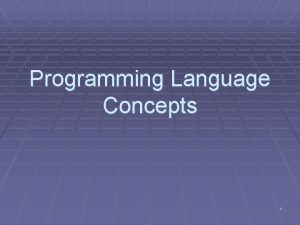Chapter 2 Programming Language Syntax Programming Language Pragmatics












































- Slides: 44

Chapter 2 : : Programming Language Syntax Programming Language Pragmatics Michael L. Scott Copyright © 2009 Elsevier

Parsing: recap • There are large classes of grammars for which we can build parsers that run in linear time – The two most important classes are called LL and LR • LL stands for 'Left-to-right, Leftmost derivation'. • LR stands for 'Left-to-right, Rightmost derivation’ Copyright © 2009 Elsevier

Parsing • LL parsers are also called 'top-down', or 'predictive' parsers & LR parsers are also called 'bottom-up', or 'shift-reduce' parsers • There are several important sub-classes of LR parsers – SLR – LALR • (We won't be going into detail on the differences between them. ) Copyright © 2009 Elsevier

Parsing • You commonly see LL or LR (or whatever) written with a number in parentheses after it – This number indicates how many tokens of look-ahead are required in order to parse – Almost all real compilers use one token of look -ahead • The expression grammars we have seen have all been LL(1) (or LR(1)), since they only look at the next input symbol Copyright © 2009 Elsevier

LL Parsing • Here is an LL(1) grammar that is more realistic than yesterday’s (based on Fig 2. 15 in book): 1. 2. 3. 4. 5. 6. 7. 8. 9. program stmt_list → stmt list $$$ → stmt_list | ε stmt → id : = expr | read id | write expr → term_tail → add op term_tail | ε Copyright © 2009 Elsevier

LL Parsing • 10. 11. • • LL(1) grammar (continued) term → factor fact_tailt fact_tail → mult_op fact_tail | ε factor → ( expr ) | id | number add_op → + | mult_op → * | / Copyright © 2009 Elsevier

LL Parsing • This one captures associativity and precedence, but most people don't find it as pretty as an LR one would be – for one thing, the operands of a given operator aren't in a RHS together! – however, the simplicity of the parsing algorithm makes up for this weakness • How do we parse a string with this grammar? – by building the parse tree incrementally Copyright © 2009 Elsevier

LL Parsing • Example (average program) read A read B sum : = A + B write sum / 2 • We start at the top and predict needed productions on the basis of the current left-most non-terminal in the tree and the current input token Copyright © 2009 Elsevier

LL Parsing • Parse tree for the average program (Figure 2. 17) Copyright © 2009 Elsevier

LL Parsing: actual implementation • Table-driven LL parsing: you have a big loop in which you repeatedly look up an action in a two-dimensional table based on current leftmost non-terminal and current input token. The actions are (1) match a terminal (2) predict a production (3) announce a syntax error Copyright © 2009 Elsevier

LL Parsing • LL(1) parse table for parsing for calculator language Copyright © 2009 Elsevier

LL Parsing • To keep track of the left-most non-terminal, you push the as-yet-unseen portions of productions onto a stack – for details see Figure 2. 20 • The key thing to keep in mind is that the stack contains all the stuff you expect to see between now and the end of the program – what you predict you will see Copyright © 2009 Elsevier

LL Parsing • The algorithm to build predict sets is tedious (for a "real" sized grammar), but relatively simple • It consists of three stages: – (1) compute FIRST sets for symbols – (2) compute FOLLOW sets for non-terminals (this requires computing FIRST sets for some strings) – (3) compute predict sets or table for all productions Copyright © 2009 Elsevier

LL Parsing • Algorithm First/Follow/Predict: – FIRST(α) == {a : α →* a β} ∪ (if α =>* ε THEN {ε} ELSE NULL) – FOLLOW(A) == {a : S →+ α A a β} ∪ (if S →* α A THEN {ε} ELSE NULL) – Predict (A → X 1. . . Xm) == (FIRST (X 1. . . Xm) - {ε}) ∪ (if X 1, . . . , Xm →* ε then FOLLOW (A) ELSE NULL) • Large example on next slide… Copyright © 2009 Elsevier

LL Parsing Copyright © 2009 Elsevier

LL Parsing Copyright © 2009 Elsevier

LL Parsing • If any token belongs to the predict set of more than one production with the same LHS, then the grammar is not LL(1) • A conflict can arise because – the same token can begin more than one RHS – it can begin one RHS and can also appear after the LHS in some valid program, and one possible RHS is ε Copyright © 2009 Elsevier

LR Parsing • LR parsers are almost always table-driven: – like a table-driven LL parser, an LR parser uses a big loop in which it repeatedly inspects a twodimensional table to find out what action to take – unlike the LL parser, however, the LR driver has non-trivial state (like a DFA), and the table is indexed by current input token and current state – the stack contains a record of what has been seen SO FAR (NOT what is expected) Copyright © 2009 Elsevier

LR Parsing • A scanner is a DFA – it can be specified with a state diagram • An LL or LR parser is a Push Down Automata, or PDA – a PDA can be specified with a state diagram and a stack • the state diagram looks just like a DFA state diagram, except the arcs are labeled with <input symbol, top-ofstack symbol> pairs, and in addition to moving to a new state the PDA has the option of pushing or popping a finite number of symbols onto/off the stack Copyright © 2009 Elsevier

LR Parsing • An LL(1) PDA has only one state! – well, actually two; it needs a second one to accept with, but that's all – all the arcs are self loops; the only difference between them is the choice of whether to push or pop – the final state is reached by a transition that sees EOF on the input and the stack Copyright © 2009 Elsevier

LR Parsing • An LR (or SLR/LALR) PDA has multiple states – it is a "recognizer, " not a "predictor" – it builds a parse tree from the bottom up – the states keep track of which productions we might be in the middle • The parsing of the Characteristic Finite State Machine (CFSM) is based on – Shift – Reduce Copyright © 2009 Elsevier

LR Parsing • To illustrate LR parsing, consider the grammar (from Figure 2. 24): 1. 2. 3. 4. 5. 6. 7. 8. program → stmt list $$$ stmt_list → stmt_list stmt | stmt → id : = expr | read id | write expr → term | expr add op term Copyright © 2009 Elsevier

LR Parsing • LR grammar (continued): 9. term → factor 10. | term mult_op factor 11. factor →( expr ) 12. | id 13. | number 14. add op → + 15. | 16. mult op → * 17. | / Copyright © 2009 Elsevier

LR Parsing • This grammar is SLR(1), a particularly nice class of bottom-up grammar – it isn't exactly what we saw originally – we've eliminated the epsilon production to simplify the presentation • When parsing, mark current position with a “. ”, and can have a similar sort of table to mark what state to go to Copyright © 2009 Elsevier

LR Parsing Copyright © 2009 Elsevier

LR Parsing Copyright © 2009 Elsevier

LR Parsing Copyright © 2009 Elsevier

Syntax Errors • When parsing a program, the parser will often detect a syntax error – Generally when the next token/input doesn’t form a valid possible transition. • What should we do? – Halt and find closest rule that does match. – Recover and continue parsing if possible. • Most compilers don’t just halt; this would mean ignoring all code past the error. – Instead, goal is to find and report as many errors as possible. Copyright © 2009 Elsevier

Syntax Errors: approaches • Method 1: Panic mode: • Define a small set of “safe symbols”. – In C++, start from just after next semicolon – In Python, jump to next newline and continue • When an error occurs, computer jumps back to last safe symbol, and tries to compile from the next safe symbol on. – (Ever notice that errors often point to the line before or after the actual error? ) Copyright © 2009 Elsevier

Syntax Errors: approaches • Method 2: Phase-level recovery – Refine panic mode with different safe symbols for different states – Ex: expression -> ), statement -> ; • Method 3: Context specific look-ahead: – Improves on 2 by checking various contexts in which the production might appear in a parse tree – Improves error messages, but costs in terms of speed and complexity Copyright © 2009 Elsevier

Beyond Parsing: Ch. 4 • We also need to define rules to connect the productions to actual operations concepts. • Example grammar: E → E + T E → E – T E → T T → T * F T → T / F T → F F → - F • Question: Is it LL or LR? Copyright © 2009 Elsevier

Attribute Grammars • We can turn this into an attribute grammar as follows (similar to Figure 4. 1): E E E T T T F F F → → → → → E + T E – T T T * F T / F F - F (E) const Copyright © 2009 Elsevier E 1. val E. val T 1. val T. val F 1. val F. val = = = = = E 2. val + E 2. val T 2. val * T 2. val / F. val - F 2. val E. val C. val T. val F. val

Attribute Grammars • The attribute grammar serves to define the semantics of the input program • Attribute rules are best thought of as definitions, not assignments • They are not necessarily meant to be evaluated at any particular time, or in any particular order, though they do define their left-hand side in terms of the right-hand side Copyright © 2009 Elsevier

Evaluating Attributes • The process of evaluating attributes is called annotation, or DECORATION, of the parse tree [see next slide] – When a parse tree under this grammar is fully decorated, the value of the expression will be in the val attribute of the root • The code fragments for the rules are called SEMANTIC FUNCTIONS – Strictly speaking, they should be cast as functions, e. g. , E 1. val = sum (E 2. val, T. val), cf. , Figure 4. 1 Copyright © 2009 Elsevier

Evaluating Attributes Copyright © 2009 Elsevier

Evaluating Attributes • This is a very simple attribute grammar: – Each symbol has at most one attribute • the punctuation marks have no attributes • These attributes are all so-called SYNTHESIZED attributes: – They are calculated only from the attributes of things below them in the parse tree Copyright © 2009 Elsevier

Evaluating Attributes • In general, we are allowed both synthesized and INHERITED attributes: – Inherited attributes may depend on things above or to the side of them in the parse tree – Tokens have only synthesized attributes, initialized by the scanner (name of an identifier, value of a constant, etc. ). – Inherited attributes of the start symbol constitute run-time parameters of the compiler Copyright © 2009 Elsevier

Evaluating Attributes – Example • Attribute grammar in Figure 4. 3: E → T TT E. v =TT. v TT. st = T. v TT 1 → + T TT 2 TT 1. v = TT 2. v TT 2. st = TT 1. st + T. v TT 1 → - T TT 1. v = TT 2. v TT 2. st = TT 1. st - T. v TT → ε TT. v = TT. st T → F FT T. v =FT. v FT. st = F. v Copyright © 2009 Elsevier

Evaluating Attributes– Example • Attribute grammar in Figure 4. 3 (continued): FT 1 → * F FT 2 FT 1. v = FT 2. v FT 2. st = FT 1. st * F. v FT 1 → / F FT 2 FT 1. v = FT 2. v FT 2. st = FT 1. st / F. v FT → ε F 1 → - F 2 FT. v = FT. st F 1. v = - F 2. v F → ( E ) F. v = E. v F → const F. v = C. v • Figure 4. 4 – parse tree for (1+3)*2 Copyright © 2009 Elsevier

Evaluating Attributes– Example Copyright © 2009 Elsevier

Bison • Bison does parsing, as well as allowing you to attribute actual operations to the parsing as it goes. • It naturally extends flex: – Takes tokenized output – Allows parsing of the tokens, and then execution of code defined by the parsing • Our simple example (which is still pretty long!) will be of a calculator language – Similar to earlier grammars we say, where * (multiplication) has higher priority than + • For more examples, see flex/bison book by O’Reilly – “real” examples take several pages!

Using Bison: an example parser • Flex code:

Now, the bison • Bison is then used to add the parsing (cont. on next slide):

Bison example (continued)
 Linguistic subsystems
Linguistic subsystems Syntax directed definition
Syntax directed definition Syntax programming
Syntax programming What is syntax in programming example
What is syntax in programming example Assembly language instruction
Assembly language instruction Diction syntax figurative language
Diction syntax figurative language Java language syntax
Java language syntax Syntax
Syntax Criteria language syntax
Criteria language syntax Diction imagery
Diction imagery Hardware description language
Hardware description language What is pragmatic analysis
What is pragmatic analysis What is pragmatics in linguistics with examples
What is pragmatics in linguistics with examples Pragmatics exercises with answers
Pragmatics exercises with answers Reference and inference
Reference and inference Pragmatic examples
Pragmatic examples Examples of invisible meaning in pragmatics
Examples of invisible meaning in pragmatics What is pragmatics in linguistics
What is pragmatics in linguistics Spatial deixis examples
Spatial deixis examples Pragmatic wastebasket
Pragmatic wastebasket Difference between semantics and pragmatics
Difference between semantics and pragmatics Presupposition in linguistics
Presupposition in linguistics Foreground entailment example
Foreground entailment example Pragmatics examples
Pragmatics examples Branches of semantics
Branches of semantics Semantics vs pragmatics
Semantics vs pragmatics Example of presupposition
Example of presupposition Conversational maxims
Conversational maxims Background knowledge in discourse analysis
Background knowledge in discourse analysis Contrastive pragmatics
Contrastive pragmatics Pragmatic examples
Pragmatic examples Solidarity definition
Solidarity definition Context in pragmatics
Context in pragmatics Pragmatics
Pragmatics Discourse deixis
Discourse deixis Sentential semantics
Sentential semantics Spatial deixis
Spatial deixis What are pragmatics
What are pragmatics Person deixis examples
Person deixis examples Structurism
Structurism High considerateness style
High considerateness style Indirect speech act
Indirect speech act Structuralism swiss
Structuralism swiss Generalized implicature examples
Generalized implicature examples Relevance theory in pragmatics
Relevance theory in pragmatics
